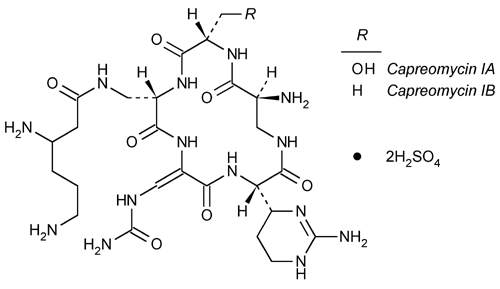Capreomycin Sulfate
» Capreomycin Sulfate is the disulfate salt of capreomycin, a polypeptide mixture produced by the growth of Streptomyces capreolus, suitable for parenteral use. It has a potency equivalent to not less than 700 µg and not more than 1050 µg of capreomycin per mg.
Packaging and storage—
Preserve in tight containers.
Labeling—
Where it is intended for use in preparing injectable dosage forms, the label states that it is sterile or must be subjected to further processing during the preparation of injectable dosage forms.
Identification—
It responds to the tests for Sulfate  191
191 .
.
pH  791
791 :
between 4.5 and 7.5, in a solution containing 30 mg per mL.
:
between 4.5 and 7.5, in a solution containing 30 mg per mL.
Loss on drying  731
731 —
Dry about 100 mg in vacuum at a pressure not exceeding 5 mm of mercury at 100
—
Dry about 100 mg in vacuum at a pressure not exceeding 5 mm of mercury at 100 for 4 hours: it loses not more than 10.0% of its weight.
for 4 hours: it loses not more than 10.0% of its weight.
Residue on ignition  281
281 :
not more than 3.0%, the charred residue being moistened with 2 mL of nitric acid and 5 drops of sulfuric acid.
:
not more than 3.0%, the charred residue being moistened with 2 mL of nitric acid and 5 drops of sulfuric acid.
Heavy metals, Method II  231
231 :
0.003%.
:
0.003%.
Capreomycin I content—
Mobile phase—
Dissolve 0.5 g of ammonium bisulfate in 1000 mL of water, and filter through a filter having a porosity of 0.5 µm or less. Prepare a mixture of this solution and methanol (550:450), and degas. Make adjustments if necessary (see System Suitability under Chromatography  621
621 ).
).
Resolution solution—
Prepare a solution of USP Capreomycin Sulfate RS in water containing about 0.25 mg per mL.
Test preparation—
Prepare a solution of Capreomycin Sulfate in water containing about 0.25 mg per mL.
Chromatographic system
(see Chromatography  621
621 )—The liquid chromatograph is equipped with a 268-nm detector and a 4.6-mm × 15-cm column that contains packing L10 with a 3.5% carbon loading. The flow rate is about 1.5 mL per minute. Chromatograph the Resolution solution, and record the peak responses as directed for Procedure: the tailing factors for the major peaks (capreomycin IA and capreomycin IB) are not more than 2.5; and the resolution between the capreomycin IA peak and the capreomycin IB peak is not less than 1.5.
)—The liquid chromatograph is equipped with a 268-nm detector and a 4.6-mm × 15-cm column that contains packing L10 with a 3.5% carbon loading. The flow rate is about 1.5 mL per minute. Chromatograph the Resolution solution, and record the peak responses as directed for Procedure: the tailing factors for the major peaks (capreomycin IA and capreomycin IB) are not more than 2.5; and the resolution between the capreomycin IA peak and the capreomycin IB peak is not less than 1.5.
Procedure—
[note—Use peak areas where peak responses are indicated.] Inject about 20 µL of the Test preparation into the chromatograph, record the chromatogram, and measure the responses for all of the peaks. Calculate the percentage of capreomycin I in the Capreomycin Sulfate taken by the formula:
100(rIA + rIB) / rt
in which rIA and rIB are the responses of the capreomycin IA peak and the capreomycin IB peak, respectively; and rt is the total of the responses for all of the peaks in the chromatogram. The capreomycin I content is not less than 90.0%.
Other requirements—
Where the label states that Capreomycin Sulfate is sterile, it meets the requirements under Injections  1
1 , and it meets the requirements for Bacterial endotoxins under Capreomycin for Injection. Where the label states that Capreomycin Sulfate must be subjected to further processing during the preparation of injectable dosage forms, it meets the requirements for Bacterial endotoxins under Capreomycin for Injection.
, and it meets the requirements for Bacterial endotoxins under Capreomycin for Injection. Where the label states that Capreomycin Sulfate must be subjected to further processing during the preparation of injectable dosage forms, it meets the requirements for Bacterial endotoxins under Capreomycin for Injection.
Assay—
Proceed with Capreomycin Sulfate as directed under Antibiotics—Microbial Assays  81
81 .
.
Auxiliary Information—
Please check for your question in the FAQs before contacting USP.
Chromatographic Column—
| Topic/Question | Contact | Expert Committee |
| Monograph | Ahalya Wise, M.S.
Scientist 1-301-816-8161 |
(MDANT05) Monograph Development-Antibiotics |
| Reference Standards | Lili Wang, Technical Services Scientist 1-301-816-8129 RSTech@usp.org |
USP32–NF27 Page 1777
Chromatographic columns text is not derived from, and not part of, USP 32 or NF 27.
